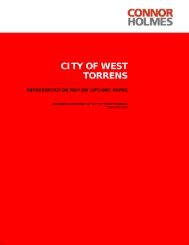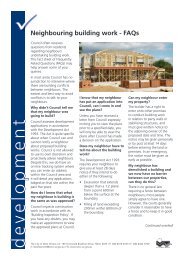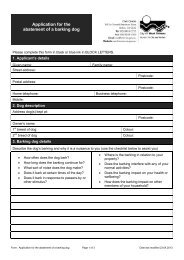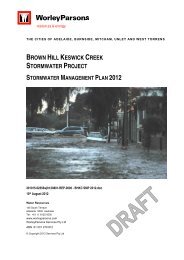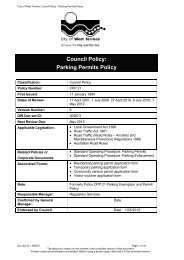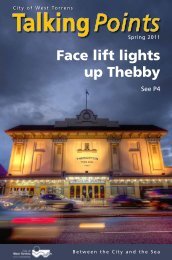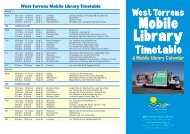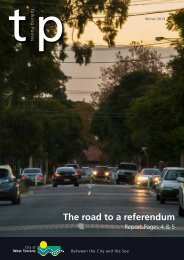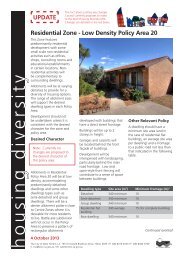Recommendations - City of West Torrens - SA.Gov.au
Recommendations - City of West Torrens - SA.Gov.au
Recommendations - City of West Torrens - SA.Gov.au
You also want an ePaper? Increase the reach of your titles
YUMPU automatically turns print PDFs into web optimized ePapers that Google loves.
‘ Increasingly, higher density<br />
housing is becoming the<br />
norm in residential areas.<br />
As a consequence, parking<br />
demand may flow onto the<br />
road system, resulting in<br />
increasing competition for<br />
limited road space.’<br />
The land use changes in the <strong>City</strong> is a<br />
significant source <strong>of</strong> increasing parking<br />
demands.<br />
the same allotment. As a consequence,<br />
the parking demand generated by the<br />
same allotment would be more than<br />
doubled. If adequate <strong>of</strong>f-street parking<br />
is not provided, the parking demand<br />
would flow onto the road system<br />
resulting in increasing competition for<br />
the limited road space.<br />
The standard 2-vehicle household<br />
also appears to be changing. As adult<br />
children remain longer in the household,<br />
parking demand also increases per<br />
household if the adult children own cars.<br />
expected to generate a parent pick up<br />
demand <strong>of</strong> 1 space per 6 students, ie<br />
100 spaces.<br />
Such a high parking demand <strong>of</strong> very<br />
short duration is difficult to manage,<br />
particularly with limited road space for<br />
on-street parking. In most instances,<br />
this short term parking demand is<br />
accommodated by the road system.<br />
The <strong>City</strong> has to, therefore, design<br />
parking controls, manage and enforce<br />
these controls to maximise the parking<br />
availability for the school.<br />
For land uses that have been in<br />
existence for many years, for example<br />
in the District Centre in <strong>Torrens</strong>ville,<br />
the provision <strong>of</strong> <strong>of</strong>f-street parking<br />
has in many instances not been<br />
a requirement in the past. As a<br />
consequence, the increase in business<br />
associated with these premises has<br />
resulted in increasing parking demands<br />
on the road network.<br />
An example is an existing rest<strong>au</strong>rant<br />
with no <strong>of</strong>f-street parking. If there is<br />
no change <strong>of</strong> use proposed, the <strong>City</strong><br />
has no enforcement power to require<br />
an existing rest<strong>au</strong>rant to provide<br />
<strong>of</strong>f-street parking. Therefore, as the<br />
rest<strong>au</strong>rant becomes popular, customer<br />
parking generated would have to rely<br />
solely on on-street parking.<br />
Other “trends” are summarised below.<br />
Residential land uses<br />
Increasingly, higher density is becoming<br />
the “norm” in residential areas. Where<br />
previously only one property was<br />
located in a relatively large allotment,<br />
sub-division or development results in<br />
two or sometimes three dwellings on<br />
112<br />
Retail land uses<br />
With the extension <strong>of</strong> trading hours<br />
for retail and 7-day trading now<br />
permitted, the peak parking <strong>of</strong> these<br />
users have reduced. In the past, most<br />
councils apply a parking rate <strong>of</strong> 7<br />
spaces per 100m2 to retail floor space.<br />
In recent years, this has reduced to 5.5<br />
spaces per 100m2.<br />
In the case <strong>of</strong> the <strong>Torrens</strong>ville District<br />
Centre, many <strong>of</strong> the shops and<br />
supermarkets have not provided<br />
adequate <strong>of</strong>f-street parking and<br />
therefore on-street parking is very<br />
high in the side streets adjacent to<br />
this centre. As a result, residents are<br />
affected.<br />
Monitoring <strong>of</strong> the parking conditions<br />
in these situations would assist in<br />
quantifying the increase in parking<br />
demand associated with retail land<br />
uses.<br />
Schools<br />
School parking is characterised by very<br />
high peaks during the starting and<br />
dismissal periods. As a rule <strong>of</strong> thumb, a<br />
600-student primary school would be<br />
Part 3 - Parking Management | Overview <strong>of</strong> Future Parking Characteristics<br />
Many private schools have provision<br />
for <strong>of</strong>f-street parking for staff and<br />
student parking, bus parking and also<br />
some parent parking.<br />
For public schools, it has been the<br />
policy <strong>of</strong> the State <strong>Gov</strong>ernment to<br />
not provide <strong>of</strong>f-street parking for<br />
parents, due to liability concerns. As a<br />
consequence, total reliance on onstreet<br />
parking is necessary.<br />
Any proposed expansion <strong>of</strong> existing<br />
schools should therefore be assessed<br />
very carefully to ensure that adequate<br />
parking is provided <strong>of</strong>f-street, or that the<br />
impact <strong>of</strong> on-street parking is not overly<br />
detrimental on adjacent land uses.<br />
Other specific land uses<br />
There are a number <strong>of</strong> “non-standard”<br />
land uses that are large parking<br />
generators. Examples include hospitals<br />
and call centres.<br />
For instance, Ashford Hospital<br />
generates high staff parking demands,<br />
particularly during shift overlaps.<br />
As many staff do not wish to pay<br />
for parking in the <strong>of</strong>f-street car park




